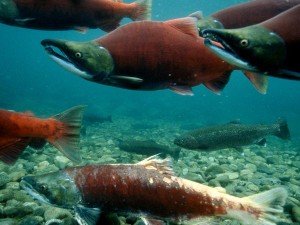Research led by a New Zealand scientist has shown that salmon farming in Canada may be having a negative impact on wild populations due to the spread of parasites.
 The research, undertaken by Dr Martin Krkosek, from Otago Univeristy, and Canadian colleagues, reveals that declines in wild populations of salmon are linked to levels of sea lice in salmon farms. The findings were published this week in the international journal Proceedings of the National Academy of Sciences.
The research, undertaken by Dr Martin Krkosek, from Otago Univeristy, and Canadian colleagues, reveals that declines in wild populations of salmon are linked to levels of sea lice in salmon farms. The findings were published this week in the international journal Proceedings of the National Academy of Sciences.
The results refute earlier research which suggested salmon farms had no impact on wild populations. The study also comes at a critical time for salmon fishing in Canada, as a government appointed group – the Cohen Commission – is currently investigating the decline of salmon in the Fraser river in British Columbia.
Dr Krkosek provided the SMC with the following commentary. Feel free to use these quotes in your stories. Please contact the SMC if you would like to talk to an expert.
“Salmon are known for their keystone role in coastal ecosystems as well as for the delectable nourishment that we enjoy. Increasingly, the salmon we eat are farmed in aquaculture cages in coastal seas where their wild cousins also live. Wild salmon carry a multitude of natural parasites, some of which can thrive in the salmon farms. The potential effect of the parasite outbreaks in farms on the health of wild salmon stocks has long been controversial.
“A new study appearing in PNAS analyzed fisheries and aquaculture data from Canada and found a link between parasite levels on farmed fish and the productivity of wild stocks. When the parasite numbers on farmed salmon are high, the wild salmon stocks that share those waters tend to decline. Although salmon farmers can use medications to protect their own fish from parasites, it appears they may need even stronger controls in order to protect their wild neighbours.
“I think this is unlikely to be a problem in NZ salmon aquaculture at present because operations here are relatively small-scale and have high environmental performance. However, it is worth noting that time and again disease has emerged as a fundamental problem in aquaculture as industries expand. Diseases tend to break out when animals and/or people get crowded together, and as aquaculture industries continue to grow and expand globally, it is likely that disease will emerge in areas of high intensity production.
“As we have seen with salmon and sea lice, this can create problems for not only the fish being raised in an aquaculture farm but also for wild fish that inhabit the surrounding waters. There are lessons to be learned here for the future of aquaculture development in NZ, which is a future growth area.”
The study has received little media interest in New Zealand but the research has gained much attention in Canada
Coverage:
TIME: Study Says Sea Lice From Farmed Salmon Do Hurt Wild Fish
Vancouver Sun: Wild salmon deaths linked to sea lice at fish farms: study
Straight.com (Vancouver): Study shows sea lice killing wild salmon
CFJC TV7: Researches says lice killing wild salmon
Times Colonist: Wild salmon deaths linked to sea lice at fish farms
CBC News: Sea lice linked to wild salmon mortality
Updated
Canada.com: Study says fish-farm sea lice linked to salmon deaths
Huffington Post: Sea Lice From Farmed Salmon Infect Wild Salmon After All, Says New Study
Phys.org: Lice from farmed salmon imperil wild salmon, new study confirms